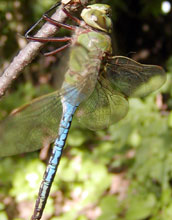Multimedia Gallery
Common Green Darner Dragonfly, Male
Common Green Darner Dragonfly, Male
Common Green Darner (Anax junius) male (photo taken in Iowa).
The common green darner, of the family Aeshnidae, is a widespread dragonfly often seen patrolling over fields some distance from water. Green darners are very large dragonfly with a length of 2 3/4 to 3 1/8 inches (68 to 80 millimeters). The thorax of the male is brownish green to yellowish green and unmarked. The abdomen is bright blue, changing to green towards the rear, and marked with black. The female is primarily yellowish green and marked with brownish black on the abdomen.
Dragonflies typically eat mosquitoes, midges and other small insects like flies, bees and butterflies. They are usually found around lakes, ponds, streams and wetlands because their larvae, known as "nymphs", are aquatic. Dragonflies do not normally bite or sting humans (though they will bite in order to escape, for example, if grasped by the abdomen); in fact, they are valued as a predator that helps control the populations of harmful insects, such as mosquitoes. (Date of Image: July 10, 2004)
Credit: Photo by Ann Johnson
Images and other media in the National Science Foundation Multimedia Gallery are available for use in print and electronic material by NSF employees, members of the media, university staff, teachers and the general public. All media in the gallery are intended for personal, educational and nonprofit/non-commercial use only.
Images credited to the National Science Foundation, a federal agency, are in the public domain. The images were created by employees of the United States Government as part of their official duties or prepared by contractors as "works for hire" for NSF. You may freely use NSF-credited images and, at your discretion, credit NSF with a "Courtesy: National Science Foundation" notation.
Additional information about general usage can be found in Conditions.
Also Available:
Download the high-resolution JPG version of the image. (757 KB)
Use your mouse to right-click (Mac users may need to Ctrl-click) the link above and choose the option that will save the file or target to your computer.

